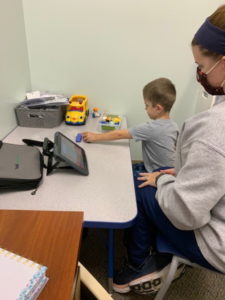 Childhood development does not hit the pause button even in the face of a pandemic. Children learn through play and exploration, and we are committed here at Therapy Playground to provide the necessary resources to ensure your kiddo is continuing to make strides in their development. Occupational Therapy addresses a range of developmental needs of children, and this blog will focus on the fine motor development of your toddler. Fine motor skills develop as your child develops, however, it is important that parents understand how to facilitate the “right” kind of practice. This blog will include the importance of fine motor development and 15 fine motor activities that can be used with everyday items.
Childhood development does not hit the pause button even in the face of a pandemic. Children learn through play and exploration, and we are committed here at Therapy Playground to provide the necessary resources to ensure your kiddo is continuing to make strides in their development. Occupational Therapy addresses a range of developmental needs of children, and this blog will focus on the fine motor development of your toddler. Fine motor skills develop as your child develops, however, it is important that parents understand how to facilitate the “right” kind of practice. This blog will include the importance of fine motor development and 15 fine motor activities that can be used with everyday items.
Fine motor refers to the ability to manipulate small items. Did you know that in order to have mobility of your hands, you must first have stability of your core muscles? “Proximal stability for distal mobility”, is a term I heard frequently during my studies. Fine motor skills are directly related to the ability to achieve gross motor movements such as jumping, running and kicking.
Kiddos who have fine motor delays may become frustrated when completing a task, or display behaviors to completely avoid the task. Fine motor delays can impact a child’s academic, play, and self-care skills. As children improve their fine motor skills they develop their independence in doing a range of tasks such as eating, writing, creating, and dressing themselves. They are able to access a wider source of learning activities and social experiences. I have included a variety of fine motor activities you can complete with your kiddo.
DISCLAIMER Your child may become obsessed with these fine motor activities. Play at your own risk ☺*
1. Push cotton balls into a plastic container. Use a water bottle with your young toddler, and push cotton balls into container until full. To make it more aesthetically pleasing, you can buy colorful pom poms from Walmart.
2. Place coins in the slit of a plastic container. You can use real coins or fake ones Smaller coins promote more refined grasp. Larger coins are less of a choking hazard. You can use almost any type of container that is clean and empty. That means those old containers that are collecting dust can be used to help your kiddo.
3. Pinch toothpicks and drop them in the holes of a spice container. Cinnamon containers are the perfect size for toothpicks! Quick and easy, right??
4. Cut Q-tips in half and drop them in a Tic-Tac container. This is an activity that can be completed to keep your little one occupied during an appointment or while waiting in line at the grocery store. It’s portable, quiet, and easy to do over and over again!
5. Make shapes in play dough with cookie cutters. I know I love making homemade cookies, this is the perfect opportunity to use that fine motor power. If you do not have playdough, encourage your kiddo to help you bake cookies and they will be in charge of
making the cookie shapes.
6. Smash play dough with a potato smasher. Growing up my mom made the BEST homemade mashed potatoes. This is a great way to engage your kiddos fine motor, gross motor, and social skills. If you don’t have play dough, have your kid help you smash some actual potatoes.
7. Drop marbles into a hole in the top of a plastic container. The weight and firm texture of the marbles give more sensory feedback than pom poms. Encourage an open web space between thumb and pointer by making an “O” with the fingers.
8. Push beads into play dough. Pretend you’re searching for treasure, and the beads are diamonds. Who knew searching for treasure cane exercise those finger muscles?
9. Squeeze chip clips onto the rim of a plastic container. Then take them off. Then put them back on again.. To really strengthen those little fingers and hands, encourage your kiddo to squeeze and pinch with their fingertips, as opposed to squeezing with their
palm.
10. Put pipe cleaners in the holes of a colander. Another incredibly simple yet repetitive and engaging activity
11. Put Cheerios on pipe cleaners. This is a great skill for older toddlers to start practicing, and is safer for the little ones who still want to put real beads in their mouths. Shoelaces work well too if you don’t have any pipe cleaners.
12. Stack beads on dry spaghetti. It can actually be pretty tricky to put the beads on without breaking the noodles! Use Cheerios if you’re worried about your toddler or preschooler putting small beads in their mouth.
13. Bend a straw in half and use it as tongs for crumpled napkin bits. Especially useful when trying to entertain your kids while waiting for your food at a restaurant
14. Drop toothpicks through a straw. Pretty self-explanatory right? ☺
15. Peel fruit. I find it challenging to peel those little cuties. To make the task easier, start the peeling and have your child finish it off.
The purpose of this blog is to help parents increase the carryover of skills that are being taught during Occupational Therapy sessions. Unfortunately, we only see your kiddo a couple hours a week. It is VERY important that these skills are being transferred over into the home, so we can make the greatest impact. We’re all in this together *cue high school musical*
-Camille Branch, OTS
